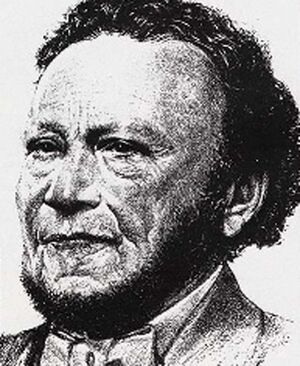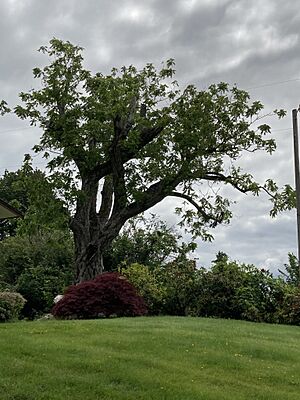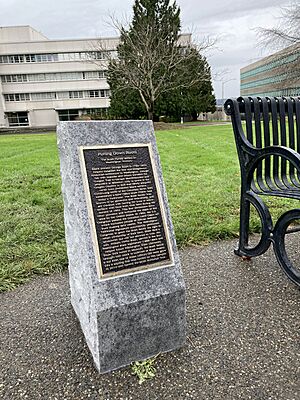George Bush (pioneer) facts for kids
Quick facts for kids
George Bush
|
|
|---|---|

Sketch of George Bush by Sam Patrick, 1969. Courtesy Henderson House Museum.
|
|
| Born | c. 1779 |
| Died | April 5, 1863 (aged 83–84) |
| Burial place | Bush/Union/Pioneer Calvary Cemetery Tumwater, Washington |
| Spouse(s) | Isabella James |
George Bush (around 1779 – April 5, 1863) was a brave American pioneer. He was one of the first settlers in the Pacific Northwest who had both African and Irish ancestors. His leadership and kindness helped build a new community in what is now the state of Washington.
Contents
Early Life and Family
George Bush was born in Pennsylvania around 1779. He was an only child and grew up in a Quaker household in Philadelphia. His father, Matthew Bush, was from India, and his mother was an Irish maid. They met while working for a wealthy merchant.
At that time, some places had unfair laws that made it difficult for people of different races to marry. However, his parents were able to marry in 1778. When their employer died, he had no other family, so he left his fortune to the Bush family. This gave George a good start in life.
As a young man, George moved to Illinois and later to Missouri, where he started a successful cattle business.
A Soldier and an Explorer
Bush was also a soldier. He fought for the United States under General Andrew Jackson in the War of 1812 at the famous Battle of New Orleans.
After the war, he worked as a fur trapper and explorer. He traveled through the wilderness with a Frenchman named Joseph Robidoux IV. For several years, he worked in the Oregon Country for the well-known Hudson's Bay Company (HBC). These adventures taught him a lot about the land and how to survive in the wild.
Family Life in Missouri
While living in Missouri, George Bush married Isabella James on July 4, 1830. Isabella was the daughter of a minister. Together, they had nine sons, and six of them survived to become adults.
Missouri was a slave state, which meant it had laws that treated people differently based on their race. Although George was a free and successful man, he and his family faced growing prejudice, which is when people are treated unfairly. Because of this, they decided to move west to find a better life and more opportunities.
The Long Journey West
In 1844, Bush and his family, along with five other families, set out on the famous Oregon Trail. Because of his experience as an explorer, Bush was the perfect guide for the group. His wife, Isabella, was a skilled nurse, which was very helpful on the long journey.
The Bush family was known for being very generous. They bought six large wagons and filled them with enough supplies to last a year. They also helped several other families pay for the trip. Bush was a true leader who cared for everyone in his party.
A New Home in the Northwest
After more than four months of travel, the group reached the Oregon Country. However, they faced a big problem. The government in Oregon had passed an "exclusion law," which was an unfair rule that banned Black people from settling there.
Founding Bush Prairie
Instead of giving up, Bush led the group north across the Columbia River. This area was not yet under the same unfair laws. They created a new settlement called Bush Prairie, which is now the city of Tumwater.
George Bush and his friend Michael Simmons built the area's first gristmill (for grinding grain) and sawmill (for cutting wood). Bush also brought new farming tools, like the first mower and reaper, to the region in 1856. He planted many types of fruit trees that he had brought with him from Missouri.
Securing His Land
In 1846, the land where Bush settled officially became part of the United States. This created a problem because the unfair laws from Oregon could now apply to him. His right to own his farm was in danger.
When the Washington Territory was created in 1853, the new leaders recognized how important Bush was to the community. They asked the U.S. Congress to pass a special act that would give George Bush and his family full ownership of their land. Congress agreed in 1855. This made him one of the first African-American landowners in Washington State.
A Generous Neighbor
The Bush family was famous for their kindness. They ran their home like a free hotel for travelers, always offering a good meal and a place to rest. George also had excellent relationships with the local Amerindians and helped care for them during sickness.
He was especially generous to his fellow settlers. One year, there was a shortage of wheat, and a buyer offered Bush a very high price for his entire crop. Bush's response showed his true character:
"I'll just keep my grain to let my neighbors who have had failures have enough to live on and for seeding their fields in the spring. They have no money to pay your fancy prices and I don't intend to see them want for anything in my power to provide them with."
George Bush died on April 5, 1863, and was buried in Tumwater. He is remembered as a founding father of his community.
Legacy and Honors
George Bush's story is an important part of American history. It shows how people from different backgrounds worked together to build new communities in the West.
- Family Legacy: His six sons continued his tradition of farming and public service. His oldest son, William Owen Bush, served in the Washington State Legislature and helped create the college that is now Washington State University.
- Art and Memorials: In 1973, the artist Jacob Lawrence created five paintings showing Bush's journey to the West. These paintings are now in the Washington State Historical Society.
- The Bush Butternut Tree: A special butternut tree was planted on the grounds of the Washington State Capitol in 2009. It grew from a seedling that George Bush himself brought on his wagon in 1845. The original tree was one of the oldest in the country before it died in 2021.
- State Capitol Monument: In 2021, a monument honoring George Bush and his family was placed on the Washington State Capitol campus. It celebrates his contributions to Washington's history.
See also




